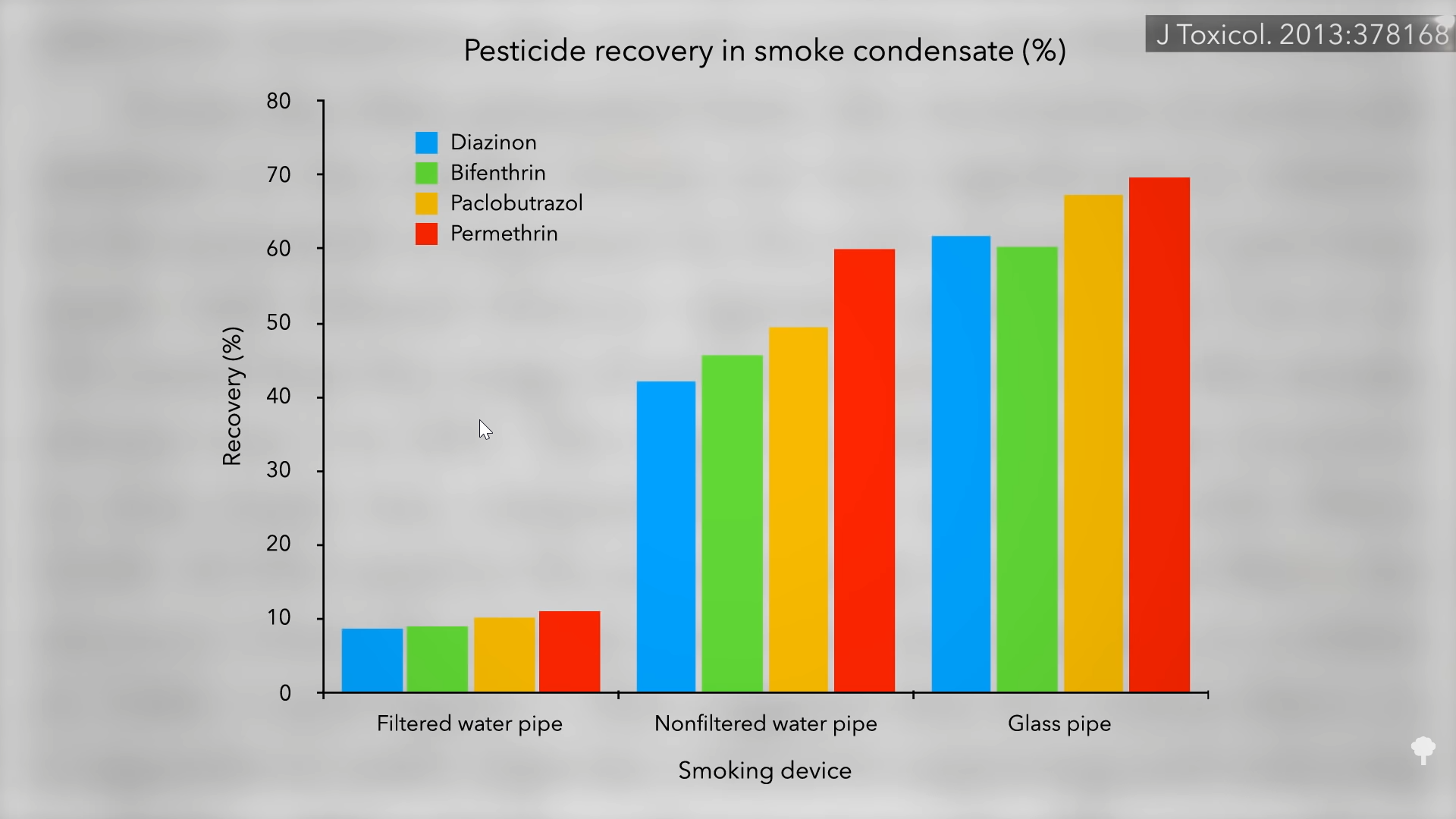[ad_1]
The largest barrier to lowering poisonous pesticides in hashish is, not surprisingly, the hashish trade itself.
California was the primary state to legalize medical marijuana. When labs began reporting they have been discovering excessive ranges of pesticide residues, the Los Angeles metropolis authorities “covertly acquired after which examined three medical hashish samples obtainable to sufferers by means of dispensaries and located that in two of the [three] samples exceedingly excessive ranges of bifenthrin [a pesticide] have been discovered,” as much as a thousand occasions the authorized restrict.
However how a lot finally ends up inside the patron? As I focus on in my video Pesticides in Marijuana, solely about 10 % of the pesticides in tobacco make it by means of a filtered cigarette, which was discovered to be similar to utilizing hashish in a water pipe with filters hooked up. However, as you may see within the graph under and at 0:45 in my video, in the event you use an everyday bong, about half of the pesticides find yourself in your lungs, and utilizing a glass pipe is even worse. As a result of most customers don’t connect a carbon filter with 7.5 grams of activated charcoal to their bongs, “generally the portion of pesticide restoration is alarmingly excessive and is a critical concern.” “Though it stays unknown exactly how damaging these chemical substances are to people, the actual fact they’re current in smoke at such excessive ranges needs to be regarding.” In line with researchers, “Contemplating these outcomes, excessive pesticide publicity by means of hashish smoking is a major chance, which can result in additional well being issues in hashish customers”—particularly if we’re speaking about medical marijuana use by sick, susceptible folks.

“The potential of pesticide and chemical residue exposures to hashish customers is substantial and will pose a major toxicological risk within the absence of enough regulatory frameworks.” Okay, so what are states doing about it? Colorado lately suffered some excessive profile recollects of marijuana batches contaminated with dangerous pesticides that made it into among the edibles. Evidently, “growers typically discover themselves fairly overwhelmed by pest points…[and] resort to nuclear ways,” attempting something to guard their crops. This has created “a public security risk,” with “intensified toxicity in concentrated merchandise of specific concern.” In reality, “pesticide ranges have been roughly 10x increased in concentrated hashish merchandise,” just like the oils and waxes typically utilized in edibles or dabbed as concentrates, “than the flower heads.”
A examine of pesticide use on hashish crops in Oregon discovered an identical downside. A survey of samples off of retailer cabinets in Washington state discovered 5 out of six to be contaminated, together with with “probably neurotoxic and carcinogenic brokers.” Many samples “harbored a number of contaminants,” attaining ranges that have been principally off the chart, together with 24 distinct pesticide brokers, pesticides, and fungicides, and none of them is authorized to be used on hashish. However it isn’t their fault. The EPA hasn’t authorized any as a result of hashish continues to be a federally unlawful crop. In reality, testing labs in California have “change into hesitant to publicize their service or listing brokers for which they might assay [test], as they suspected that such data” may simply be used as an instruction guide of types by “unscrupulous growers to hunt out probably extra poisonous brokers.”
So simply regulate it then. That’s been tried, however guess what the largest barrier has been? Shock, shock, it has been the multibillion-dollar hashish trade. “Just like the tobacco trade earlier than it, the hashish trade is making an attempt to weaken pesticide rules pertaining to hashish. Reportedly, the Colorado Division of Agriculture: ‘…initially hoped to restrict permissible pesticides to probably the most unhazardous,’” however this proposal was quashed by trade pushback, identical to the tobacco trade has been capable of do.
Huge Tobacco “has offered an in depth street map” for King Hashish: “Deny habit potential, downplay recognized adversarial well being results, create as massive a market as attainable as shortly as attainable, and defend that market by means of lobbying, marketing campaign contributions, and different advocacy efforts.” Certainly, “bolstered by huge income,” the tobacco trade was capable of get itself “exempted from each main piece of shopper safety laws even after the lethal penalties of tobacco have been established.” That needs to be a cautionary story for us now, provided that public well being advocates have definitively fewer billions of {dollars} to work with.
Huge Tobacco might not simply be offering the roadmap, however ready within the wings to personal the street. “On account of litigation towards the tobacco trade, greater than 80 million pages of inner firm paperwork grew to become obtainable….These paperwork reveal that since at the least 1970, regardless of fervent denials, main multinational tobacco corporations,” together with Philip Morris, have been scheming, keen, and ready to enter the legalized marijuana market to change into Huge Blunt. “Due to the tobacco trade’s demonstrated capability and willingness to change its merchandise to extend addictiveness, obfuscate data, deceive the general public, and use promoting to focus on susceptible teams to extend demand, the trade additionally has the ability to dramatically change (and increase) using marijuana.”
For extra on the hyperlink between the tobacco and hashish industries, take a look at Will Hashish Flip Into Huge Tobacco?.
[ad_2]







































Discussion about this post